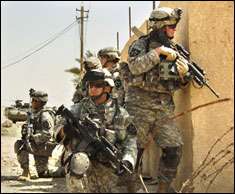Building real security with virtual worlds

(PhysOrg.com) -- Advances in computerized modeling and prediction of group behavior, together with improvements in video game graphics, are making possible virtual worlds in which defense analysts can explore and predict results of many different possible military and policy actions, say computer science researchers at the University of Maryland in a commentary published in the November 27 issue of the journal Science.
"Defense analysts can understand the repercussions of their proposed recommendations for policy options or military actions by interacting with a virtual world environment... They can propose a policy option and walk skeptical commanders through a virtual world where the commander can literally 'see' how things might play out. This process gives the commander a view of the most likely strengths and weaknesses of any particular course of action," write authors V.S. Subrahmanian, a Maryland computer science professor and director of the University's Institute for Advanced Computer Studies (UMIACS), and John Dickerson, a UMIACS computer science researcher.
Computer scientists now know pretty much how to do this, and have created a "pretty good chunk" of the computing theory and software required to build a virtual Afghanistan, Pakistan or another "world," explains Subrahmanian, who notes that much of the leading edge of this work has been done at the University of Maryland.
"Human analysts, with their real world knowledge and experience, will be essential partners in taking us the rest of the way in building these digital worlds and, then, in using them to predict courses of action most likely to build peace and security in Afghanistan and elsewhere."
In their Science "Perspectives" article Subrahmanian and Dickerson note that researchers at the University of Maryland have developed a number of the computing pieces critical to building virtual worlds. These include stochastic opponent modeling agents (SOMA) - artificial intelligence software that uses data about past behavior of groups in order to create rules about the probability of that group various actions in different situations; "cultural islands," which provide a virtual world representation of a real-world environment or terrain, populated with characters from that part of the world who behave in accordance with a behavioral model; and forecasting "engines" CONVEX and CAPE, which focus on predicting behavioral changes in groups based on validated on historical data.
Writing about virtual worlds that will be created in the near future, he and Dickerson say that "U.S. defense analysts can use such virtual worlds to interact with models of the behaviors of these groups and understand how certain actions they might take will affect the short-term and long-term behaviors of these groups. At any given point in time, the game has a 'state' describing, for instance, the situation in a town. When U.S. forces or a local government take actions such as opposing a local leader, that state is altered. A group may react in one of several ways in accordance with a [mathematically-based] probability distribution."
"We are now at the point where, with the help of the analysts, we can start thinking about building computer-generated models that can automatically adapt to changes in group behaviors and to conditions on the ground," Subrahmanian adds.
Provided by University of Maryland (news : web)
















